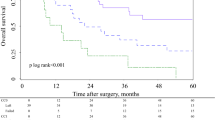Abstract
Background
The debate remains whether appendiceal goblet cell cancers behave as classical carcinoid or adenocarcinoma. Treatment options are unclear and reports of outcomes are scarce. Cytoreductive surgery and hyperthermic intraperitoneal chemotherapy (CRS+HIPEC) is considered optimal treatment for peritoneal involvement of other epithelial appendiceal tumors.
Methods
Prospective cohorts of patients treated for advanced appendiceal tumors from three peritoneal malignancy centres were collected (1994–2011). All patients underwent complete CRS+HIPEC, when possible, or tumor debulking. Demographic and outcome data for patients with goblet cell cancers were compared to patients with low- or high-grade epithelial appendiceal tumors treated during the same time period.
Results
Details on 45 goblet cell cancer patients were compared to 708 patients with epithelial appendix lesions. In the goblet cell group, 57.8 % were female, median age was 53 years, median peritoneal cancer index (PCI) was 24, and CRS+HIPEC was achieved in 71.1 %. These details were similar in patients with low- or high-grade epithelial tumors. Lymph nodes were involved in 52 % of goblet cell patients, similar to rates in high-grade cancers, but significantly higher than in low-grade lesions (6.4 %; p < 0.001). At 3 years, overall survival (OS) was 63.4 % for goblet cell patients, intermediate between that for high-grade (40.4–52.2 %) and low-grade (80.6 %) tumors. On multivariate analysis, tumor histology, PCI, and achievement of CRS+HIPEC were independently associated with OS.
Conclusions
This data supports the concept that appendiceal goblet cell cancers behave more as high-grade adenocarcinomas than as low-grade lesions. These patients have reasonable long-term survival when treated using CRS+HIPEC, and this strategy should be considered.

Similar content being viewed by others
References
Turaga KK, Pappas SG, Gamblin TC. Importance of histologic subtype in the staging of appendiceal tumors. Ann Surg Oncol. 2012;19:1379–85.
McCusker ME, Coté TR, Clegg LX, Sobin LH. Primary malignant neoplasms of the appendix: a population-based study from the surveillance, epidemiology and end-results program, 1973–1998. Cancer. 2002;94:3307–12.
Tang LH, Shia J, Soslow RA, et al. Pathologic classification and clinical behavior of the spectrum of goblet cell carcinoid tumors of the appendix. Am J Surg Pathol. 2008;32:1429–43.
van Eeden S, Offerhaus GJA, Hart AAM, et al. Goblet cell carcinoid of the appendix: a specific type of carcinoma. Histopathology. 2007;51:763–73.
Alsaad KO, Serra S, Schmitt A, Perren A, Chetty R. Cytokeratins 7 and 20 immunoexpression profile in goblet cell and classical carcinoids of appendix. Endocr Pathol. 2007;18:16–22.
Jiang Y, Long H, Wang W, et al. Clinicopathological features and immunoexpression profiles of goblet cell carcinoid and typical carcinoid of the appendix. Pathol Oncol Res. 2011;17:127–32.
Plöckinger U, Couvelard A, Falconi M, et al. Consensus guidelines for the management of patients with digestive neuroendocrine tumours: well-differentiated tumour/carcinoma of the appendix and goblet cell carcinoma. Neuroendocrinology. 2008;87:20–30.
Hristov AC, Young RH, Vang R, et al. Ovarian metastases of appendiceal tumors with goblet cell carcinoidlike and signet ring cell patterns: a report of 30 cases. Am J Surg Pathol. 2007;31:1502–11.
Chua TC, Moran BJ, Sugarbaker PH, et al. Early- and long-term outcome data of patients with pseudomyxoma peritonei from appendiceal origin treated by a strategy of cytoreductive surgery and hyperthermic intraperitoneal chemotherapy. J Clin Oncol. 2012;30:2449–56.
Chua TC, Yan TD, Smigielski ME, et al. Long-term survival in patients with pseudomyxoma peritonei treated with cytoreductive surgery and perioperative intraperitoneal chemotherapy: 10 years of experience from a single institution. J Clin Oncol. 2009;16:1903–11.
Baratti D, Kusamura S, Nonaka D, et al. Pseudomyxoma peritonei: clinical pathological and biological prognostic factors in patients treated with cytoreductive surgery and hyperthermic intraperitoneal chemotherapy (HIPEC). Ann Surg Oncol. 2008;15:526–34.
El Halabi H, Gushchin V, Francis J, et al. The role of cytoreductive surgery and heated intraperitoneal chemotherapy (CRS/HIPEC) in patients with high-grade appendiceal carcinoma and extensive peritoneal carcinomatosis. Ann Surg Oncol. 2012;19:1–5.
Cashin P, Nygren P, Hellman P, et al. Appendiceal adenocarcinoids with peritoneal carcinomatosis treated with cytoreductive surgery and intraperitoneal chemotherapy: a retrospective study of in vitro drug sensitivity and survival. Clin Colorectal Cancer. 2011;10:108–12.
Mahteme H, Sugarbaker PH. Treatment of peritoneal carcinomatosis from adenocarcinoid of appendiceal origin. Br J Surg. 2004;91:1168–73.
Bruin SC, Verwaal VJ, Vincent A, van’t Veer LJ, van Velthuysen MLF. A clinicopathologic analysis of peritoneal metastases of colorectal and appendiceal origin. Ann Surg Oncol. 2010;17:2330–40.
Stewart JH, Shen P, Russell GB, et al. Appendiceal neoplasms with peritoneal dissemination: outcomes after cytoreductive surgery and intraperitoneal hyperthermic chemotherapy. Ann Surg Oncol. 2006;13:624–34.
Carr N, Sobin LH. Tumors of the appendix. In: Bosman F, Carneiro F, Hruban RH, et al, editors. Vol WHO classification of tumors of the digestive system. 4th ed. Lyon, France: IARC Press; 2010. pp 122–125.
Ronnett BM, Zahn CM, Kurman RJ, et al. Disseminated peritoneal adenomucinosis and peritoneal mucinous carcinomatosis. A clinicopathologic analysis of 109 cases with emphasis on distinguishing pathologic features, site of origin, prognosis, and relationship to “pseudomyxoma peritonei.” Am J Surg Pathol. 1995;19:1390–408.
Gilly FN, Cotte E, Brigand C, et al. Quantitative prognostic indices in peritoneal carcinomatosis. Eur J Surg Oncol. 2006;32:597–601.
Dindo D, Demartines N, Clavien P-A. Classification of surgical complications: a new proposal with evaluation in a cohort of 6336 patients and results of a survey. Ann Surg. 2004;240:205–13.
Acknowledgment
No conflicts of interest and no research grants were received for this study.
Author information
Authors and Affiliations
Corresponding author
Rights and permissions
About this article
Cite this article
McConnell, Y.J., Mack, L.A., Gui, X. et al. Cytoreductive Surgery with Hyperthermic Intraperitoneal Chemotherapy: An Emerging Treatment Option for Advanced Goblet Cell Tumors of the Appendix. Ann Surg Oncol 21, 1975–1982 (2014). https://doi.org/10.1245/s10434-013-3469-5
Received:
Published:
Issue Date:
DOI: https://doi.org/10.1245/s10434-013-3469-5




